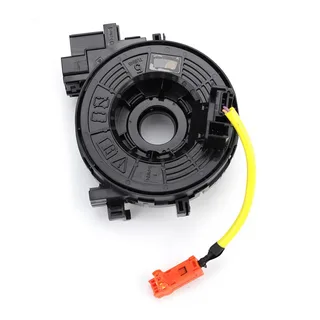The Toyota Hilux is renowned for its durability and robust performance, making it a popular choice for personal and professional use. One of the crucial components ensuring the seamless operation of its various features is the Toyota Hilux Clock Spring. Understanding how to maintain and replace this part can prevent unnecessary complications and expenses. In this blog post, we’ll explore everything from its function to maintenance tips that can help prolong its life. Regular inspection of the clock spring is essential to catch any signs of wear or damage early.
Understanding the Function of the Clock Spring for Toyota Hilux
The clock spring, often called the spiral cable, is a crucial component in the steering system of the Toyota Hilux and many other vehicles. Its primary function is maintaining the electrical connection between the steering wheel and the vehicle’s electrical systems while allowing the steering wheel to rotate freely. This component ensures that various systems, such as the airbag, horn, and steering wheel controls, function properly.
When the steering wheel is turned, the clock spring unwinds and rewinds to accommodate the movement without losing the electrical connection. If the clock spring is damaged or fails, it can lead to several issues. For example, the airbag may not deploy in a collision, posing a significant safety risk to the driver and passengers. Additionally, controls for the horn and audio system may stop working, leading to inconvenience and potential distractions while driving.
Regular inspection and maintenance of the clock spring are essential, especially in vehicles like the Toyota Hilux, which are often used for off-road driving and heavy-duty applications. Signs of a malfunctioning clock spring may include a warning light on the dashboard, a non-functioning horn, or issues with steering wheel-mounted controls. If any of these symptoms occur, it is advisable to have the clock spring inspected and replaced if necessary to ensure the safety and functionality of the vehicle.
In conclusion, the clock spring for Toyota Hilux is a small but vital component that significantly contributes to the vehicle’s overall safety and operability. Understanding its function and recognising the signs of wear can help maintain the vehicle’s performance and ensure a safe driving experience.
Common Symptoms of a Faulty Toyota Hilux Clock Spring Replacement
The clock spring is a critical component in the Toyota Hilux, connecting the steering wheel to the vehicle’s electrical systems while allowing for rotation. A faulty clock spring can lead to various issues that may affect the driver’s safety and the functionality of essential features. Recognising the common symptoms of a defective clock spring can help you address the problem before it leads to more severe complications.
One of the most noticeable symptoms of a faulty clock spring is the failure of the airbag warning light to illuminate. If the clock spring malfunctions, the connection between the airbag system and the steering wheel can be disrupted. This may result in the airbag not deploying in the event of an accident, posing a serious safety risk. If you notice that the airbag warning light is illuminated or remains off when it should be on, it’s essential to have the clock spring inspected immediately.
Another common symptom is a loss of steering wheel controls. Many modern vehicles, including the Toyota Hilux, have buttons on the steering wheel for audio controls, cruise control, and Bluetooth connectivity. If these controls become unresponsive, it may indicate a problem with the clock spring, as it is responsible for maintaining electrical connections while allowing for steering wheel rotation.
Additionally, unusual noises can be a sign of a failing clock spring. When turning the wheel, drivers may hear clicking or popping sounds from the steering column. This can result from the internal components of the clock spring wearing out or becoming misaligned.
If you experience any of these symptoms, it is crucial to seek professional assistance. Timely Toyota Hilux clock spring replacement can enhance vehicle safety and restore the functionality of important steering wheel controls.
Diagnosing the Hilux Clock Spring Issues
The clock spring in a Toyota Hilux is a crucial component of the steering system. It connects the steering wheel to the airbag, horn, and other controls. Diagnosing issues with the clock spring can prevent potential safety hazards and ensure the vehicle functions properly.
Symptoms of Clock Spring Issues
One of the first signs of Hilux clock spring problems is the airbag warning light illuminating on the dashboard. This indicates a potential malfunction in the airbag system, often linked to the clock spring. Additionally, if the horn is unresponsive or the controls on the steering wheel (like audio or cruise control) fail to work, it could be due to a faulty clock spring. Drivers may also experience unusual noises when turning the steering wheel, which can signify wear or damage.
Diagnostic Steps
To diagnose these issues, start by visually inspecting the steering wheel and column for any obvious signs of damage or wear. Then, check for any trouble codes using an OBD-II scanner; this can provide insight into the specific malfunction. If the scanner indicates a clock spring-related error, it may be necessary to remove the steering wheel to access the clock spring for a thorough inspection.
Resolution
If damage or wear is evident, replacing the clock spring is recommended. Follow proper safety protocols when working with airbag systems, as improper handling can lead to unintended deployment. Regular maintenance and timely diagnosis can extend the life of your Hilux and maintain its safety features.
Replacing a Faulty Clock Spring
A clock spring, a spiral spring, is a crucial component in various mechanical systems, including watches, automotive steering, and some machinery. When it becomes faulty, it can lead to operational issues, making it essential to replace it promptly. Here’s a step-by-step guide to help you through the process.
Tools and Materials Needed
Before starting, gather the necessary tools: a screwdriver set, pliers, a replacement clock spring, and safety goggles. Ensure you have a clean, well-lit workspace to avoid losing small components.
Step-by-Step Process
Disconnect Power:
Always disconnect the power source to avoid shocks or further damage if you’re working with an electrical system.
Remove the Cover:
Use the screwdriver to remove the casing that protects the clock spring carefully. Keep screws in a labelled container for easy reassembly.
Take Out the Faulty Spring:
Gently detach the faulty clock spring from its housing. You may need to use pliers to free any stubborn clips or attachments.
Install the New Spring:
Align the new clock spring with the mounting points and secure it. Ensure it fits snugly to prevent any movement during operation.
Reassemble and Test:
Replace the cover and reconnect the power. Test the system’s functionality to ensure the new clock spring works correctly.
Replacing a faulty clock spring can seem daunting, but following these steps will help you confidently tackle the task. Always consult a professional if you encounter difficulties or are unsure about any part of the process.
Preventative Maintenance Tips for Prolonging Clock Spring Life
The clock spring is a crucial component in the steering system of modern vehicles. It maintains electrical connections between the steering wheel and various systems like the airbag, horn, and cruise control. Regular preventative maintenance is essential to ensure its longevity. Here are some tips to help you prolong the life of your clock spring.
1. Avoid Excessive Steering Force
One of the most effective ways to protect the clock spring is to avoid applying excessive force while steering. Over-rotating or jerking the steering wheel can damage the internal wires within the clock spring. Always turn the wheel smoothly and avoid exceeding the steering limit, especially during parking maneuvers.
2. Inspect for Wear and Tear
Regular inspection of the steering wheel’s electrical components can help detect early signs of wear and tear. If you notice unusual clicking sounds, malfunctioning buttons, or an airbag light on the dashboard, it could indicate issues with the clock spring. Addressing these issues early can prevent further damage and avoid costly repairs.
3. Keep the Steering Wheel Aligned
Maintaining proper wheel alignment helps reduce unnecessary strain on the steering components, including the clock spring. Misalignment can cause uneven pressure during steering, accelerating the wear of the clock spring’s internal components. Periodic alignment checks can save your clock spring from premature failure.
4. Prevent Exposure to Moisture
Moisture can cause electrical issues and lead to the corrosion of internal parts within the clock spring. Ensure the vehicle’s cabin remains dry, especially during rainy or humid conditions. If any liquid spills occur near the steering wheel, clean them up immediately to prevent damage.
Installation Tips for the KUN26 Hilux Clock Spring
Installing a clock spring in a KUN26 Toyota Hilux can be straightforward if approached methodically. The clock spring is an essential component that ensures the proper functioning of your vehicle’s airbag system, steering wheel controls, and other electronic features. Below are some tips to help you successfully install the clock spring.
Preparation
Before beginning the installation, it’s crucial to gather all necessary tools. You will typically need a socket set, screwdrivers, and a torque wrench. The vehicle’s service manual is also advisable for specific torque specifications and procedures. Ensure the car is parked on a level surface and the ignition is turned off. Disconnect the battery to prevent any accidental airbag deployment during installation.
Removing the Steering Wheel
To access the KUN26 Hilux clock spring, you’ll need to remove the steering wheel. Start by detaching the airbag module. Carefully use a flat-head screwdriver to release the clips securing the airbag, then disconnect the wiring harness. Once the airbag is safely removed, use the appropriate socket to remove the steering wheel nut. Mark the steering wheel and shaft alignment to ensure proper reinstallation.
Installing the Clock Spring
You can now install the new clock spring with the steering wheel removed. To ensure it’s centred, align the clock spring’s marks with those on the steering column. Secure it in place with the screws provided. It’s crucial to avoid twisting the clock spring excessively during installation, as this can damage the internal wiring.
Reassembly and Testing
After installing the clock spring, reattach the steering wheel by aligning it with the marks made earlier. Secure the steering wheel nut and reconnect the airbag module. Reconnect the battery and perform a test to ensure all functions, including the airbag system, are working correctly.
Conclusion
Regularly checking and maintaining the Toyota Hilux Clock Spring ensures that vital safety features and convenience controls remain operational. You can address potential issues before they escalate by being vigilant about the common symptoms of a faulty clock spring, such as airbag warning lights or malfunctioning steering wheel controls. Diagnosing problems accurately and following a systematic replacement approach can save time and money. Implementing preventative maintenance measures, like avoiding excessive steering wheel turns when stationary and keeping the steering column clean, can also extend the clock spring’s lifespan.
FAQS
Q1: How often should the clock spring in a Toyota Hilux be replaced?
There isn’t a specific replacement interval for the clock spring. It should be checked during regular maintenance or if you notice malfunction symptoms.
Q2: Can I replace the Toyota Hilux Clock Spring myself?
Yes, you can replace the Toyota Hilux Clock Spring yourself if you have some mechanical skills and knowledge. However, it’s best to consult a professional mechanic if you’re unsure.
Q3: What happens if I ignore a faulty clock spring?
Ignoring a faulty clock spring can lead to non-functional steering wheel controls, airbag deployment issues, and compromised vehicle safety, making it crucial to address the problem promptly.



